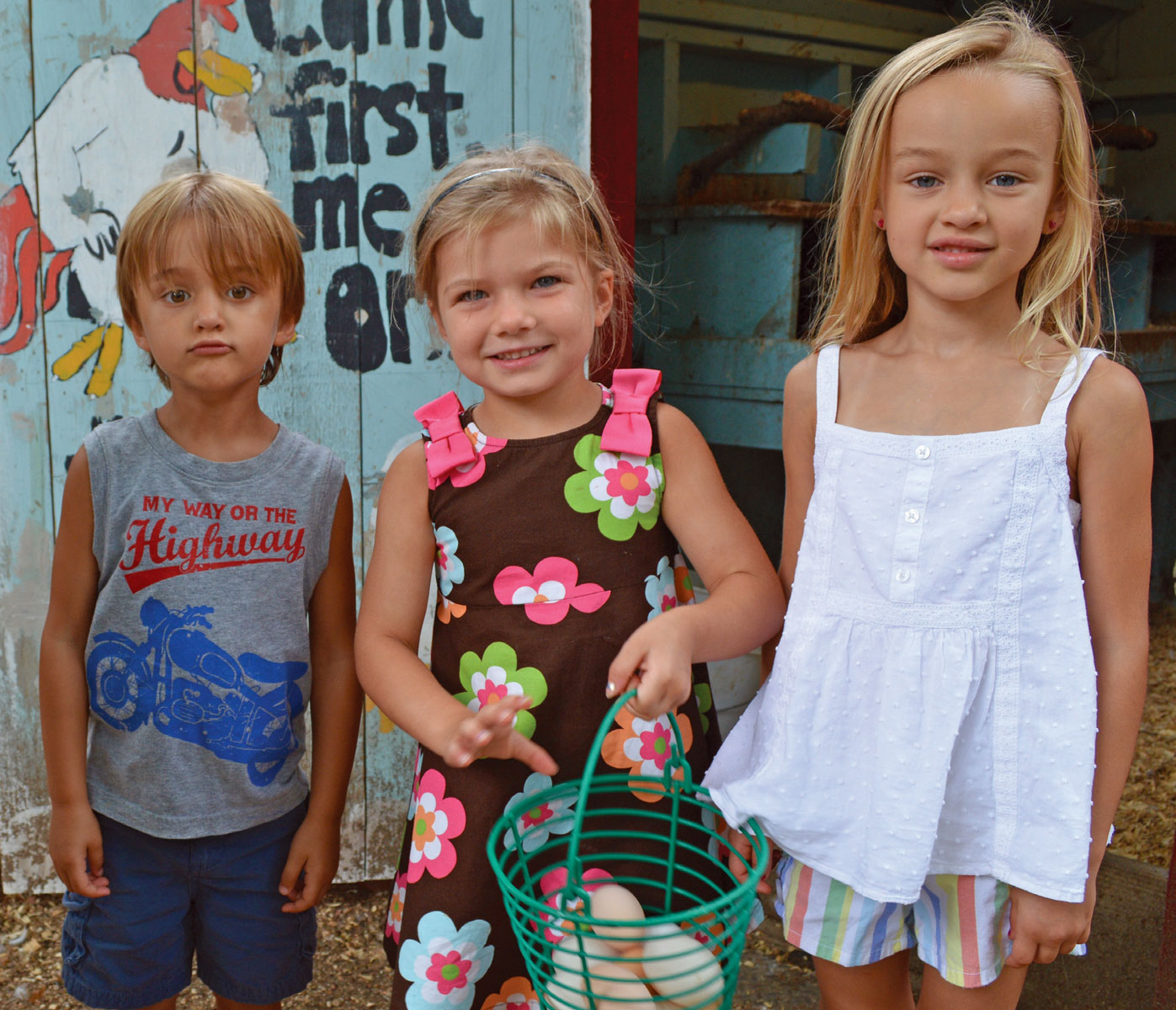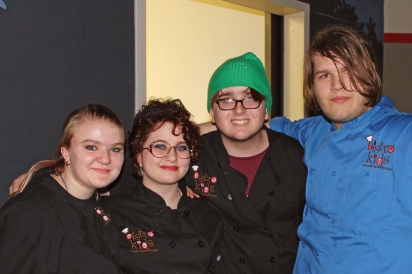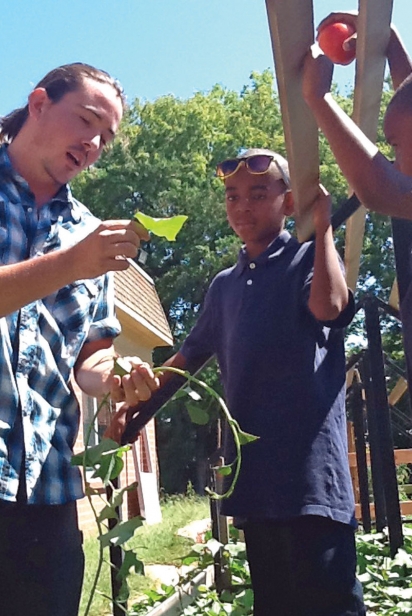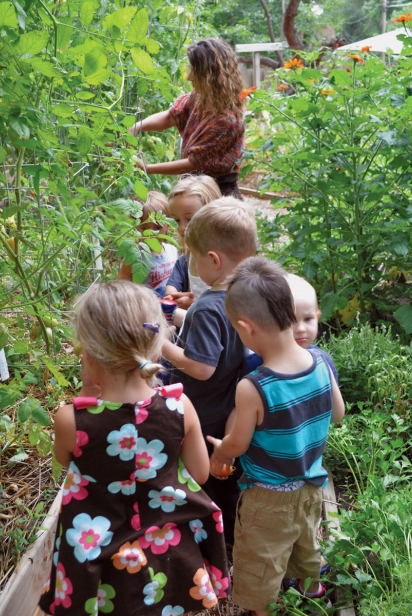Feeding Our Kids: School Gardens and a Unique Culinary Program in Kansas City
As you’re driving along Wornall Road in rush hour traffic you might be surprised to discover a delicious sanctuary for learning how to grow, prepare, and eat healthy food just beyond the tree line off 80th Street.
For more than a century Gillis Homes, a local nonprofit, has been helping at-risk children and families reach their potential through education, counseling and social services. Today the organization is also teaching its kids — many struggling at home and in public schools — how to grow their own food in an outdoor classroom they are designing and building themselves.
The non-profit is among a growing number of Kansas City organizations, public and private schools that are part of a nationwide movement to diversify learning with outdoor, edible classrooms that connect children with their food and provide a foundation for healthy living.
“This is how humans learned for generations,” said Theo Bunch, a youth education specialist and art education teacher at Gillis. “We are going beyond the traditional setting of ‘turn to page 12’ in a sterile environment to spending our days outside learning how to grow and build things while connecting with the food we eat.”
A prairie grass ecosystem greets you at the front of the Gillis outdoor learning center dotted with hand-painted, educational murals leading to a garden full of plump, red tomatoes and winding sweet potato vines. An evolving orchard of cherry, pear, and apple trees serves as a border to the garden where more than 100 kids worked together to grow everything from collards to kale and Yukon gold potatoes this summer. “This is their work; their food,” Bunch said.
What doesn’t get eaten on campus goes home with the kids with a recipe to share.
At Gillis, the garden is not only educational, but is therapeutic and has a vocational component that is naturally developing into a broader curriculum for math, science and art.
Bunch’s students designed and built their raised beds out of repurposed wood and their roofs out of old record shelves. They constructed a wind vane and sundial and are currently building a patio to enhance their garden. Lessons unfold every day as the students work as a team to build and grow their own classroom.
“We are going back to our roots,” said Bunch who grew up on a sheep farm near the Flint Hills near Manhattan, Kan. “There’s a lot of beauty in that.”
Bunch is building his program from successful models across Kansas City and with the help of other local farm-to-school pioneers.
“This is a very holistic, altruistic movement,” he said. “It’s the only way we can create a strong, alternative system in our city.”
The Evolution of Edible Classrooms
Edible classrooms are taking root across the country including school districts across Kansas and Missouri that are sourcing more foods locally and providing educational activities that emphasize food, farming, and nutrition.
The farm-to-school movement is designed to enrich children’s bodies and minds while supporting local businesses and teaching healthy living. The programs, which vary widely nationwide, aim to bring healthy foods into school cafeterias while teaching hands-on lessons.
More than 4,000 school districts participate in the U.S. Department of Agriculture Farm to School program, which provides research, training, technical assistance, and grants. More than half of those districts have their own gardens, according to a USDA census report.
A handful of organizations in Kansas City, including Gillis, are inspired by a similar farm-to-school model called The Edible Schoolyard Project. The program was crafted 20 years ago by Alice Waters, a renowned restaurateur and activist who worked with a middle school in Berkley, Calif., to transform a vacant, decaying lot into a flourishing garden.
That first project provided a platform for students to learn all aspects of farming the garden and preparing, serving, and eating food as a means of awakening their senses and encouraging an appreciation of the transformative values of nourishment, community, and stewardship of the land.
“Miracles unfold around us every day in the nature-based classroom,” said Natalie Reeder, director at Little Sprouts Montessori school in Kansas City, Kan. “We’re not just building skills, we’re building character.”
Little Sprouts has a class of about 20 students ranging in age from two to five. The garden, rich with an orchard, ponds, and a tree swing, produces everything from cucumbers to green beans and tomatoes.
The students work hard to grow their veggies from seed and are almost euphoric when they get to harvest.
Watching them make that connection is the sweet spot of teaching for Reeder, a former yoga instructor and personal chef who fell into pre-school teaching about five years ago. Also inspired by the Edible Schoolyard Project, she longed to connect children to the natural canvas of the outdoors and to the food they eat just as she did as a little girl.
“In many respects I have recreated my own childhood on a broader scale,” she said. “Watching the children make those same connections with nature is heartwarming.”
Connecting children with food is truly a huge part of the farm-to-school concept, said Dan Nelson, owner and operator of Danjo Farms, a community-supported agriculture (CSA) farm in Moberly, Mo.
He and his wife, Joanne, spent many years teaching students how to make meals out of homegrown vegetables in the Missouri Farm to School program.
“It was always very interesting to me to watch kids as they tried to make sense of things most of us would consider very simple,” said Nelson, who grew up on a farm.
As part of his lessons, Nelson would put a potato, eggplant, and tomato on a table and ask the kids to identify the veggies. Very few students could identify all of them, he said. They could, however identify a piece of pizza, bottle of ketchup, and chicken nuggets.
“They had no concept of the ketchup coming from tomatoes or French fries being made out of potatoes,” he said. “To me this was very disheartening, and it is among the many reasons these programs are so important.”
For many kids the biggest connection to their food comes from actually preparing and eating it, Nelson said. The teachers at Kansas City Academy see this every day.
The Academy, nestled in the Waldo neighborhood, is one of a handful of schools participating in Bistro Kids, a local lunchtime program designed to empower and teach students how to prepare healthy meals, and to learn life skills and good eating habits.
“What we have is more than just a lunch program,” said Susan Miller, the Academy’s development director. “We’re giving these kids a holistic look at who they are and want to be.”
From soil to stove
Lunchtime at KCA feels like a visit to grandma’s when you can smell the cooking. On this day, the hint of stir fry and simmering taco soup wafts through the old hallways leading to the tiny industrial kitchen where students are hard at work under the direction of Chef Mark Zukaitis.
Zukaitis studied at Johnson and Wales University in Charleston, S.C. before making a name for himself as a longtime chef in Kansas City at restaurants including La Bodega and corporations like Cerner and H&R Block.
Wanting to spend more time with his two young daughters, he decided to pursue teaching and was hired by Bistro Kids about five years ago to teach youth ages 2 to 18 food preparations, cooking styles, and kitchen safety.
“I believe we are changing the world one student at a time through nutrition education and our culinary arts classes we offer at all of our schools,” he said.
Zukaitis narrowed his work last year to cook and teach solely at KCA for the Bistro Kids program and has been working to enhance the school’s culinary curriculum since.
He teaches eighth graders, one junior, and three seniors. Together they create lunches sourced year round largely from local farmers and the school’s 800-squarefoot vegetable and herb garden chock full of lettuce, sorrel, arugula, squash and a hoop house bursting with ripe tomatoes.
Rainwater feeds the garden that also has a compost bin for all non-animal food scraps at the school.
Today’s menu includes chicken or tofu stir fry; melon and feta salad; tomato, red pepper, cilantro salad; brown rice; mashed veggies; and wheat flour chocolate chip cookies.
“We always have a vegetarian option on the menu and make sure to cater to the dietary needs of others in the school,” said Kyle McDonald, a senior who has studied under Zukaitis since eighth grade. “Working here in our kitchen really is a unique experience. I’ve grown to have a great appreciation for it.”
During lunch, students eat where they want, kind of like they would at home. They hang with their teachers upstairs, in hallways, in the cafeteria or library. Mostly they go where they are comfortable and where the conversation is rich.
McDonald said it’s pretty cool when he sees people enjoying his food, and admits that there have been times he has been nervous or worried that what he makes won’t turn out. But that is the beauty in having a chef, teacher, and mentor show you the way.
“When I would feel nervous I had to learn to trust him to know that if I made something that wasn’t good, he would work with me to make it better,” McDonald said. “Overall, the big thing with us is that everything we eat is really healthy. I really like that,” he said.
KCA pairs its culinary courses with physical education and nutrition lessons to provide a holistic perspective on healthy living. “I feel so much better when I eat healthy,” McDonald said. “Having learned about healthy food and worked on making it a part of my life, it’s easier to show other people how they can make it part of theirs. When that happens, we all do well.








